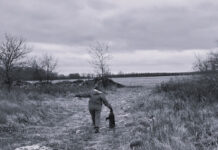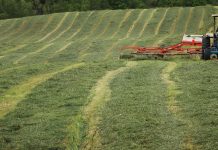As I remember it, I was about six or seven when I first heard that deep-throated, baritone “harrumph”. I was in my first-grade classroom doing one of my best show-and-tell schticks when our teacher, Mrs. Exton, chose that moment to emit a wonderful rendition of a bullfrog’s call. It actually froze the class in place and I quickly returned to my seat to let her continue her demonstration. Sadly, she must have felt she needed to get back to regular school work and that valuable lesson wasn’t continued. Still, I was amazed at her imitation of the summer’s harrumphing chorus going on around our neighbor’s pond.
To this day, I’m still not sure why she chose that particular time to show-off her impressive improvisation. She must have been trying to give me an idea for a future project. Like her usual reaction upon receiving my homework, she’d be happy to know that I’m finally getting around to it.
The musical bass of the swamps, lakes and ponds is none other than that largest of our continent’s frogs, the American bullfrog. Under the right conditions, their spring and summer song can reverberate for over a mile, lending a ghostly haunting to steamy, dark, nights.
From a scientific point of view, the bullfrog is a member of the Ranidae family which are “true frogs.” The family also includes northern and southern leopard frogs, green frogs, pickerel frogs and wood frogs. Confusingly, that leaves a few frogs that are apparently something other than true frogs (fake frogs?). Their family tree is called Hylidae and includes tree frogs, chorus frogs and the cricket frog. Before you ask, toads may look like a frog and jump like a frog but they’re, well, toads. They have their own family, Bufonidae. Scientific taxonomy is a little complex for me so we’ll just take those expert’s word on it.
True frogs
So, what makes the bullfrog a true frog? All the family members in the Ranidae family have some unique features that I’m sure turn those other frog families green with envy — or dirty brown in the toad’s case. The true frogs tend to have a slender waste, teeth on the upper jaw, webbed hind feet, horizontal eye pupils, long legs with pointy toes and a great jumping ability.
Sure, a lot of those Hylidaie’s can climb trees, leaving true frogs sitting on the ground or water bound, but true frogs are voraciously carnivorous so it’s a good thing many Hylidaie can stay out of range. Apparently, true frogs think fake frogs taste like chicken.
The bullfrog is the perfect example of their family’s true frog heritage. Its habitat includes ponds, lakes and slow-moving water where it hunts insects, crustaceans, small reptiles, birds, small mammals and other frogs. Its tongue is attached to the front of its mouth and it uses it to dart out to help capture its prey.
As mentioned, these can be big frogs … ranging up to 8 inches without a leg-stretch. Once, while fishing for bass, I noticed a young redwing blackbird fall from its nest and into the water. A sudden splash indicated a bass had grabbed it so I moved in for a cast. To my surprise, a very large bullfrog was working to swallow the bird.
Years before that, my father, brother and I were headed home from a late evening of catfishing. It was hot and a light drizzle was humidifying the landscape. Dad suddenly stopped the car and there, sitting in the middle of the dirt road, was a monster of a bullfrog. We hopped out and caught it mid-hop and put it in our empty minnow bucket. It covered the entire bottom. While dad saw a frog-leg dinner, I wanted to release it into a local pond. I won that one.
Tadpoles
If you take a close look at the true frogs, you’ll see a round disk behind the eye. That’s their eardrum or tympanum. If you ever want to know if you’re holding a male or female bullfrog, that’s your answer. Females have eardrums about the size of their eyes but they’re much larger in males.
The bullfrog’s peak breeding season is May through July. Females will deposit thousands of eggs in a protective jelly-like film with the youngsters, called tadpoles, emerging about four days after fertilization. Tadpoles grow quickly and can reach a length of seven inches. They’re carnivorous from birth, eating anything that will fit in their mouth.
Their first winter is spent as tadpoles, becoming frogs the following summer. It can sometimes take several years for them to fully transform into adults. Predators wearing fur, fins or feathers — plus the occasional kid with a Ball jar — can take their toll on tadpoles, but nature has given them a few edges. Their speckled-brown skin makes them almost invisible when they remain still on a muddy pond bottom and their long tails give them a burst of Mario Andretti’s evasive speed when they need it. An interesting fact about the tadpole’s tail is that it has the ability to re-grow if it loses it to a predator or injury.
Frog season
Their long period to maturation is one of the reasons that over-harvesting can damage local bullfrog populations which explains why regulations are in place. Fishing licenses are required to take frogs and there is a possession limit.
This year’s Ohio’s frog season began at 6 p.m. on June 14 and continues through April 30, 2025. Only bullfrogs and green frogs may be taken. No more than 15 may be taken or possessed in any one day. This helps to protect the species during the peak of their breeding season.
Who would want to eat bullfrogs? Their legs were a staple food for Native Americans and the arriving European explorers and settlers. They continue to be held in high regard by many today and in France “des cuisses de grenouille” is considered a delicacy. Many describe the meat as having a texture similar to a chicken wing with a mild flavor that’s magically crossed between fish and chicken. Didn’t I tell you true frogs thought fake frogs taste like chicken? Apparently, it goes both ways.
While I was living in Vanlue, Ohio, the New Riegel Café and Alvada’s Windmill Inn Restaurant were popular weekend eateries. While the Café remains renowned for their ribs and are a regional favorite, the now defunct Windmill had quite a buffet dinner. I really don’t remember if they offered any competing ribs, it was their frog legs that were their centerpiece of dining delectables.
So, there you go Mrs. Exton … my bullfrog show-and-tell column. Somehow, I think I can hear her imitating that “harrumph” again. She sure was funny sometimes. As I think about it, I may still owe her some homewor …
“Eat a live frog first thing in the morning and nothing worse will happen to you the rest of the day.” — Mark Twain













